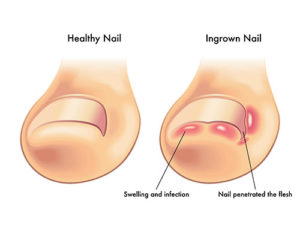SKIN AND NAIL PROCEDURES
The doctors at Commonwealth Foot and Ankle Center specialize in common skin and nail conditions.
If you are among one of the millions of people in the United States with diabetes, it is important to visit your podiatrist for regular foot examinations in order to maintain healthy feet.
Diabetics are more prone to various foot problems than those without diabetes due to the development of painful nerve damage called peripheral neuropathy. Neuropathy can affect your entire body, but most often the legs and feet develop more serious complications.
The damage to your nerves can cause loss of feeling in your feet, making it difficult to detect pain as easily as someone who does not have diabetes. As a result, you could sustain a cut, wound or injury and not even notice until after it becomes more serious. Sometimes a minor injury or cut can become infected and become serious very quickly if the feet are not being regularly examined.
Something as minor as a blister on your toe can turn serious and lead to an amputation if left untreated.
Below are some common skin and nail conditions.
INGROWN TOENAILS
Ingrown toenails are a common condition in which the corner or side of a toenail grows into the skin. It can cause pain, redness, swelling and, sometimes, an infection. If you have diabetes or another condition that causes poor blood flow to your feet, you’re at greater risk of complications of ingrown toenails.
Symptoms can include:
Pain and tenderness in your toe
Redness around your toenail
Swelling of your toe around the nail
Infection of the tissue around your toenail

Ingrown toenails can be removed with a minor, in-office surgical procedure. The toe is numbed and the portion of the nail causing pain is cut out. If you choose, a chemical can be placed at the base of the nail to kill the root so that portion of the nail can no longer grow back and cause another ingrown nail. This procedure can be done in the office and you can return back to normal shoes and activity very quickly. Most people are fully healed 2-3 weeks after the procedure is performed.
TOTAL NAIL REMOVAL
In addition to ingrown toenails, we can also remove the entire nail in the office. Some people may experience pain from deformed nails, thick nails or other toe deformities that can cause severe pain in the nail. In these cases, sometimes removal of the entire nail is the best option.
The nails can be temporarily removed so they may grown back. For chronic nail problems that will continue to cause pain once grown back out, a permanent procedure can be done so the nail will no longer grow back.
Similarly to the ingrown nail procedure, removal of the total nail is done with a quick, minor, in-office surgical procedure.
NAIL FUNGUS AND ATHLETES FOOT
Fungal nail infections are common infections of the toenails that can cause the nail to become discolored, thick, and more likely to crack and break. The technical name for a fungal nail infection is “onychomycosis.”
Nails with a fungal infection are often:
Discolored (yellow, brown, or white)
Thick
Fragile or cracked

Prevention
Keep your feet clean and dry.
Don’t walk barefoot in areas like locker rooms or public showers.
Don’t share nail clippers with other people.
When visiting a nail salon, choose a salon that is clean and licensed by your state’s cosmetology board.
Make sure the salon sterilizes its instruments (nail clippers, scissors, etc.) after each use, or, you can bring your own.
Diagnosis
We may diagnose a fungal skin or nail infection by looking at the affected area and asking questions about your symptoms. In some cases, we take a nail clipping or a skin sample to send to a laboratory for a fungal culture.
Treament
Fungal nail infections can be difficult to cure, and they typically don’t go away without antifungal treatment. We offer multiple options for treatment, based on what is best for the patient.
In some cases, the doctor may prescribe a topical medication to treat the infection. This, typically, has to be applied daily until healthy nail grows out or until the skin infection clears. Another option is prescription antifungal pills taken by mouth. This is only an option for healthy patients as this medication may affect liver function. In severe nail fungal cases, the doctor might remove the nail completely (see total nail removal above). It can take several months to a year for nail infection to go away. Skin infections, with proper treatment, usually clear within a couple of months.
WARTS
Most foot warts are harmless, even though they may be painful and are often mistaken for corns or calluses. A wart, however, is caused by a viral infection which invades the skin through small or invisible cuts and abrasions. If left untreated, warts can grow to an inch or more in circumference and can spread into clusters of warts. Children, especially teenagers, tend to be more susceptible to warts than adults.
Plantar warts appear on the soles of the feet or the “plantar surface” of the feet. Unlike other foot warts, plantar warts tend to be hard and flat, with a rough surface and well-defined boundaries. They are often gray or brown (but the color may vary), with a center that appears as one or more pinpoints of black. Because they are on the soles of the feet, they can make walking quite painful.
To prevent the spread of warts, follow these tips:
Avoid direct contact with warts, both from other persons or from other parts of the body.
Avoid walking barefoot.
Change your shoes and socks daily.
Check your children’s feet periodically.
Keep your feet clean and dry.
It is important to note that warts can be very resistant to treatment and have a tendency to reoccur. Over-the-counter foot wart treatments are usually ineffective because their use can inadvertently destroy surrounding healthy tissue.
Please contact our office for help in effectively treating warts. Our practice is expert in recommending the best treatment for each patient, which, in most cases, is treatment with a topical medication (applied in the office) that destroys the warty tissue. In the most severe cases laser cautery, which cuts the affected tissue from the foot, may be the best option.
SKIN LESIONS
Skin lesions refer to any variation in skin color or texture anywhere on the body. Some skin lesions are present at birth, such as moles, freckles, or birthmarks. Others are acquired over time, such as acne, warts, allergies, sunburn, or abrasions. Most skin lesions are harmless.
However, it is important to keep an eye on them because they can change over time, which may be indicative of a serious problem, such as skin cancer.
If you notice a change in the skin on your foot, from discoloration to an unusual lesion, contact our office immediately. We will biopsy (remove a portion of the tissue to send to the lab) so we can be certain what condition we are dealing with and treat appropriately


